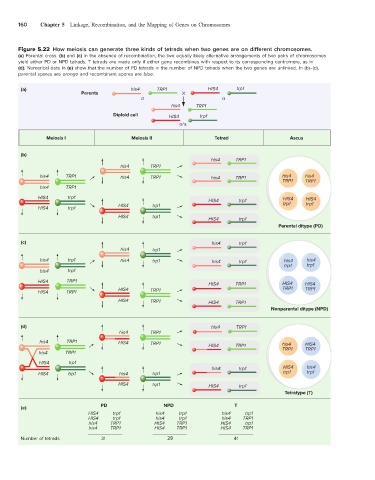Page 168 - Genetics_From_Genes_to_Genomes_6th_FULL_Part1
P. 168
160 Chapter 5 Linkage, Recombination, and the Mapping of Genes on Chromosomes
Figure 5.22 How meiosis can generate three kinds of tetrads when two genes are on different chromosomes.
(a) Parental cross. (b) and (c) In the absence of recombination, the two equally likely alternative arrangements of two pairs of chromosomes
yield either PD or NPD tetrads. T tetrads are made only if either gene recombines with respect to its corresponding centromere, as in
(d). Numerical data in (e) show that the number of PD tetrads ≈ the number of NPD tetrads when the two genes are unlinked. In (b)–(d),
parental spores are orange and recombinant spores are blue.
(a) his4 TRP1 HIS4 trp1
Parents
a
his4 TRP1
Diploid cell HIS4 trp1
a/
Meiosis I Meiosis II Tetrad Ascus
(b)
his4 TRP1
his4 TRP1
his4 TRP1 his4 TRP1 his4 TRP1 his4 his4
TRP1 TRP1
his4 TRP1
HIS4 trp1 HIS4 HIS4
HIS4 trp1
HIS4 trp1 trp1 trp1
HIS4 trp1
HIS4 trp1 HIS4 trp1
Parental ditype (PD)
(c) his4 trp1
his4 trp1
his4 trp1 his4 trp1 his4 trp1 his4 his4
trp1 trp1
his4 trp1
HIS4 TRP1
HIS4 TRP1 HIS4 HIS4
HIS4 TRP1 TRP1 TRP1
HIS4 TRP1
HIS4 TRP1 HIS4 TRP1
Nonparental ditype (NPD)
(d) his4 TRP1
his4 TRP1
his4 TRP1 HIS4 TRP1 HIS4 TRP1 his4 HIS4
his4 TRP1 TRP1 TRP1
HIS4 trp1
his4 trp1 HIS4 his4
HIS4 trp1 his4 trp1 trp1 trp1
HIS4 trp1 HIS4 trp1
Tetratype (T)
(e) PD NPD T
HIS4 trp1 his4 trp1 his4 trp1
HIS4 trp1 his4 trp1 his4 TRP1
his4 TRP1 HIS4 TRP1 HIS4 trp1
his4 TRP1 HIS4 TRP1 HIS4 TRP1
Number of tetrads 31 28 41

